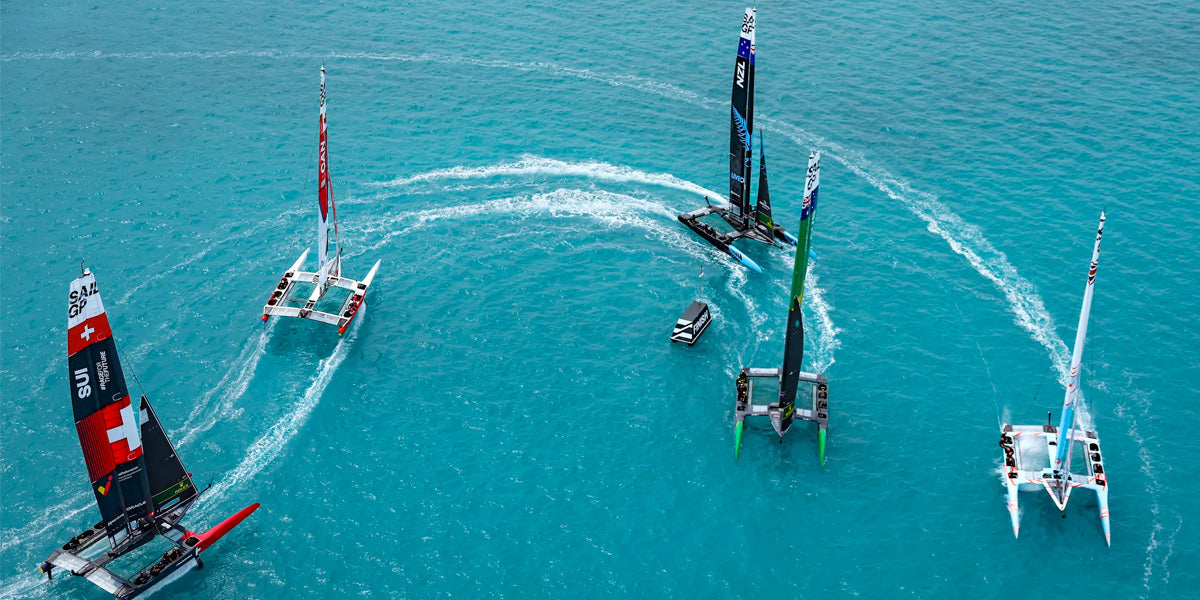From the development of enormous outboard engines to the increasing experimentation with electric boat engines, to the connected boat, the marine industry is innovating like never before.
Bill Springer, a well-known writer in the yachting world reported F50 raceboats that compete in the SailGB world racing league use rigid “wings” instead of “sails” and razor-thin hydrofoils to hit record-breaking speeds.
This article originally appeared on Denison Yachting.
I’ve been following the adrenaline-fueled SailGP league that features some of the best athletes in the world, racing some of fastest and most exciting hyrofoiling catamarans in the world, since the league was founded three years ago. And one of the many things I love about the SailGP Racing Catamaran is that the league is not only designed to showcase spectacular racing and smile-inducing speeds. SailGP’s growing list of events showcase some of the most beautiful oceanfront venues around the world and engage with people in meaningful ways that go beyond the racing results.

But, I’d never been to an event in person until recently, when I was in Bermuda to see new teams from Switzerland and Canada join teams from Australia, Denmark, France, Great Britain, Japan, New Zealand, Spain, and the United States for the start of SailGP’s third season.
Since I was still buzzing from spending the previous weekend in Miami for the inaugural Formula 1 Grand Prix (I love high-performance boats as much as I love high-performance cars), I was excited to see just how fast a F50 SailGP racing catamaran is in person. And since I started out on a small chase boat that was out to watch the fleet practice, I had a feeling just being close to these boats going 50 MPH would get my blood pumping. But, what I wasn’t prepared for was the sound these boats made as they sliced through the water (and air). It was like a high-pitched whine of a turbo-charged engine (but, these boats obviously don’t have any engines!)–and it was awesome!

Of course, my mind would have been sufficiently blown after watching the first day of practice from the media boat. But things ramped up even further when I was told that I was going to be one of the lucky few who actually get to sail on one of these hydrofoiling rocket ships.

And even the mandatory safety presentation I had prior to joining the crew of the Danish SailGP was exciting. Not only did my life jacket come with a knife and a dive regulator with a small canister of air that I’d might need to use in a worst-case scenario. I had to prove—in the water, with a safety instructor!—that I was able to use my regulator while my instructor held me underwater.

The good news was…I passed. Then, later that day, I literally “took off” aboard team Denmark SailGP, powered by Rockwool. After taking a minute to get settled in the back of the windward hull, I found myself in awe. The acceleration was unlike any other race boat I’d ever been on. The speed was intoxicating. And the sensation of “flying” over the water on razor-thin hydrofoils was even better than I had imagined it would be.

But it wasn’t until it was time to turn (sailors call it tacking but…nevermind) that I was truly able to grasp the power of an F50 raceboat. And good thing I was holding on, because an F50 raceboat creates Gs (G-forces) in a sharp turn that can be similar to what Formula 1 racecar drivers experience!
In fact, SailGP and Formula 1 are more similar that I’d even imagined, because not only do both feature some of the fastest racing in the world, they also both offer choice sponsors and a few lucky fans the chance to actually experience that speed for themselves before the racing actually starts.
As you’d imagine, I was pulling for my buddies aboard team Denmark SailGP, powered by Rockwool, when the competition started on the water later that weekend. But, since the racing—and frankly the entire SailGP experience—was so fantastic, I wasn’t too disappointed when team New Zealand SailGP won the season three opener in Bermuda. And that’s only the beginning. The United States Sail Grand Prix at Chicago’s Navy Pier takes place the weekend of June 18-19.













